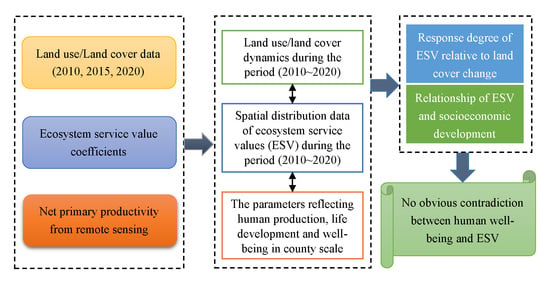Unraveling the Spatio-Temporal Relationship between Ecosystem Services and Socioeconomic Development in Dabie Mountain Area over the Last 10 years
Abstract
:1. Introduction
2. Study Area and Materials
2.1. Study Area
2.2. Datasets
3. Methodology
3.1. Determination of Ecosystem Service Value Coefficient
3.2. Method for Spatial Distribution Adjustment of ESV
3.3. Analysis of Correlation between ESV Dynamics and Socioeconomic Development
3.3.1. ESV Dynamic Change
3.3.2. Response of ESV to Land Cover Change
3.3.3. Analysis of Correlation between ESV Dynamics and Socioeconomic Factors
4. Results and Analysis
4.1. Total ESV and Its Temporal and Spatial Variation in Dabie Mountains
4.2. Response of ESV Dynamics to Land Cover Change
4.3. Relationship between ESV and Socioeconomic Development
5. Discussion
5.1. Significance of ESV Spatialization
5.2. Socioeconomic Parameters
5.3. Improvement of Research Methods
6. Conclusions
Author Contributions
Funding
Institutional Review Board Statement
Informed Consent Statement
Data Availability Statement
Acknowledgments
Conflicts of Interest
References
- MEA (Millennium Ecosystem Assessment). Ecosystems and Human Wellbeing: A Framework for Assessment; World Resources Institute: Washington, DC, USA, 2003. [Google Scholar]
- Gashaw, T.; Tulu, T.; Argaw, M.; Worqlul, A.W.; Tolessa, T.; Kindu, M. Estimating the impacts of land use/land cover changes on Ecosystem Service Values: The case of the Andassa watershed in the Upper Blue Nile basin of Ethiopia. Ecosyst. Serv. 2018, 31, 219–228. [Google Scholar] [CrossRef]
- Rector, M.E.; Filgueira, R.; Grant, J. Ecosystem services in salmon aquaculture sustainability schemes. Ecosyst. Serv. 2021, 52, 1011379. [Google Scholar] [CrossRef]
- Zheng, H.; Ouyang, Z.; Zhao, T.; Li, Z.; Xu, W. The impact of human activities on ecosystem services. J. Nat. Resour. 2003, 18, 118–126. [Google Scholar]
- Millennium Ecosystem Assessment. Ecosystems and HumanWell-Being: Synthesis; Island Press: Washington, DC, USA, 2005. [Google Scholar]
- Xie, G.; Zhang, C.; Zhang, C.; Xiao, Y.; Lu, C. The value of ecosystem services in China. Resour. Sci. 2015, 37, 1740–1746. [Google Scholar]
- Zhao, Y.; Zhu, W.; Wei, P.; Fang, P.; Zhang, X.; Yan, N.; Liu, W. Classification of Zambian grasslands using random forest feature importance selection during the optimal phenological period. Ecol. Ind. 2022, 135, 108529. [Google Scholar] [CrossRef]
- Liu, G.; Yang, Q. Non-monetary accounting on ecosystem services valuation: Theory and methodology. Chin. J. Environ. Manag. 2018, 10, 10–20. [Google Scholar]
- Comberti, C.; Thornton, T.F.; de Echeverria, V.W.; Patterson, T. Ecosystem services or services to ecosystems? Valuing cultivation and reciprocal relationships between humans and ecosystems. Glob. Environ. Chang. 2015, 34, 247–262. [Google Scholar] [CrossRef] [Green Version]
- Costanza, R.; Kubiszewski, I. The authorship structure of ecosystem services as a transdisciplinary field of scholarship. Ecosyst. Serv. 2012, 1, 16–25. [Google Scholar] [CrossRef] [Green Version]
- Braat, L.; de Groot, R. The ecosystem services agenda: Bridging the worlds of natural science and economics, conservation and development, and public and private policy. Ecosyst. Serv. 2012, 1, 4–15. [Google Scholar] [CrossRef] [Green Version]
- Costanza, R.; de Groot, R.; Sutton, P. Changes in the global value of ecosystem services. Glob. Environ. Chang. 2014, 26, 152–158. [Google Scholar] [CrossRef]
- Liu, S.; Costanza, R.; Troy, A.; D’Aagostino, J.; Mates, W. Valuing New Jersey’s ecosystem services and natural capital: A spatially explicit benefit transfer approach. Environ. Manag. 2010, 45, 1271–1285. [Google Scholar] [CrossRef]
- Frélichová, J.; Vačkář, D.; Pártl, A.; Loučková, B.; Harmáčková, Z.V.; Lorencová, E. Integrated assessment of ecosystem services in the Czech Republic. Ecosyst. Serv. 2014, 8, 110–117. [Google Scholar] [CrossRef]
- Zhang, X.; Qiu, F.; Qin, F. Identification and mapping of winter wheat by integrating temporal change information and Kullback–Leibler divergence. Int. J. Appl. Earth Obs. Geoinf. 2019, 76, 26–39. [Google Scholar] [CrossRef]
- Schägner, J.P.; Brander, L.; Maes, J.; Hartje, V. Mapping ecosystem services’ values: Current practice and future prospects. Ecosyst. Serv. 2013, 4, 33–46. [Google Scholar] [CrossRef] [Green Version]
- Bateman, I.J.; Harwood, A.R.; Mace, G.M.; Watson, R.T.; Abson, D.J.; Andrews, B.; Binner, A.; Crowe, A.; Day, B.H.; Dugdale, S.; et al. Bringing ecosystem services into economic decision-making: Land use in the United Kingdom. Science 2013, 341, 45–50. [Google Scholar] [CrossRef]
- Morshed, S.R.; Fattah, M.A.; Haque, M.N.; Morshed, S.Y. Future ecosystem service value modeling with land cover dynamics by using machine learning based Artificial Neural Network model for Jashore city, Bangladesh. Phys. Chem. Earth 2021, 103021. [Google Scholar] [CrossRef]
- Li, S. Reflections on ecosystem service research. Landsc. Archit. Front. 2019, 7, 82–87. [Google Scholar] [CrossRef]
- Crossman, N.D.; Bryan, B.A. Identifying cost- effective hotspots for restoring natural capital and enhancing landscape multi-functionality. Ecol. Econ. 2009, 68, 654–668. [Google Scholar] [CrossRef]
- Crossman, N.D.; Bryan, B.A.; Summers, D.M. Carbon payments and low-cost conservation. Conserv. Biol. 2011, 25, 835–845. [Google Scholar] [CrossRef]
- De Groot, R.; Brander, L.; van der Ploeg, S.; Costanza, R.; Bernard, F.; Braat, L.; Christie, M.; Crossman, N.; Ghermandi, A.; Hein, L.; et al. Global estimates of the value of ecosystems and their services in monetary units. Ecosyst. Serv. 2012, 1, 50–61. [Google Scholar] [CrossRef]
- Kreuter, U.; Harris, H.; Matlock, M.; Lacey, R. Change in ecosystem service values in the San Antonio area. Texas. Ecol. Econ. 2001, 39, 333–346. [Google Scholar] [CrossRef]
- Li, R.; Dong, M.; Cui, J.; Zhang, L.; Cui, Q.; He, W. Quantification of the impact of land-use changes on ecosystem services: A case study in Pingbian County. China. Environ. Monit. Assess. 2007, 128, 503–510. [Google Scholar] [CrossRef]
- Tolessa, T.; Senbeta, F.; Kidane, M. The impact of land use/land cover change on ecosystem services in the central highlands of Ethiopia. Ecosyst. Serv. 2017, 23, 47–54. [Google Scholar] [CrossRef]
- Wang, Z.; Zhang, B.; Zhang, S.; Li, X.; Liu, D.; Song, K.; Li, J.; Li, F.; Duan, H. Changes of land use and of ecosystem service values in Sanjiang Plain, Northeast China. Environ. Monit. Assess. 2006, 112, 69–91. [Google Scholar] [CrossRef]
- Limburg, K.E.; O’Neill, R.V.; Costanza, R.; Farber, S. Complex systems and valuation. Ecol. Econ. 2002, 41, 409–420. [Google Scholar] [CrossRef]
- Hein, L.; van Koppen, K.; de Groot, R.S.; van Ierland, E.C. Spatial scales, stakeholders and the valuation of ecosystem services. Ecol. Econ. 2006, 57, 209–228. [Google Scholar] [CrossRef]
- Maes, J.; Egoh, B.; Willemen, L.; Liquete, C.; Vihervaara, P.; Schägner, J.P.; Grizzetti, B.; Drakou, E.G.; La Notte, A.; Zulian, G.; et al. Mapping ecosystem services for policy support and decision making in the European Union. Ecosyst. Serv. 2012, 1, 31–39. [Google Scholar] [CrossRef]
- Wang, X.; Dong, X.; Liu, H.; Wei, H.; Fan, W.; Lu, N.; Xu, Z.; Ren, J.; Xing, K. Linking land use change, ecosystem services and human well-being: A casestudy of the Manas River Basin of Xinjiang, China. Ecosyst. Serv. 2017, 27, 113–123. [Google Scholar] [CrossRef]
- Zhang, M.; Yuan, N.; Lin, H.; Liu, Y.; Zhang, H. Quantitative estimation of the factors impacting spatiotemporal variation in NPP in the Dongting Lake wetlands using Landsat time series data for the last two decades. Ecol. Ind. 2022, 135, 108544. [Google Scholar] [CrossRef]
- Deng, X.; Yan, S.; Song, X.; Li, Z.; Mao, J. Spatial targets and payment modes of win–win payments for ecosystem services and poverty reduction. Ecol. Ind. 2022, 136, 108612. [Google Scholar] [CrossRef]
- Nelson, E.; Mendoza, G.; Regetz, J.; Polasky, S.; Tallis, H.; Cameron, R.; Chan, K.M.; Daily, G.C.; Goldstein, J.; Kareiva, P.M.; et al. Modeling multiple ecosystem services, biodiversity conservation, commodity production, and tradeoffs at landscape scales. Front. Ecol. Environ. 2009, 7, 4–11. [Google Scholar] [CrossRef]
- Pagdee, A.; Kawasaki, J. The importance of community perceptions and capacity building in payment for ecosystems services: A case study at Phu Kao, Thailand. Ecosyst. Serv. 2021, 47, 101224. [Google Scholar] [CrossRef]
- Shiferaw, H.; Bewket, W.; Alamirew, T.; Zeleke, G.; Teketay, D.; Bekele, K.; Schaffner, U.; Eckert, S. Implications of land use/land cover dynamics and Prosopis invasion on ecosystem service values in Afar Region, Ethiopia. Sci. Total Environ. 2019, 675, 354–366. [Google Scholar] [CrossRef] [PubMed]
- Li, W.; Yi, P.; Zhang, D.; Zhou, Y. Assessment of coordinated development between social economy and ecological environment: Case study of resource-based cities in Northeastern China. Sustain. Cities Soc. 2020, 59, 102208. [Google Scholar] [CrossRef]
- Huang, M.; Yue, W.; Feng, S.; Cai, J. Analysis of spatial heterogeneity of ecological security based on MCR model and ecological pattern optimization in the Yuexi county of the Dabie Mountain Area. J. Nat. Resour. 2019, 34, 771–784. [Google Scholar] [CrossRef]
- Song, W.; Deng, X.Z. Land use/land cover change and ecosystem service provision in China. Sci. Total Environ. 2017, 576, 705–719. [Google Scholar] [CrossRef]
- Wang, Y.H.; Dai, E.F.; Yin, L.; Ma, L. Land use/land cover change and the effects on ecosystem services in the Hengduan Mountain region, China. Ecosyst. Serv. 2018, 34, 55–67. [Google Scholar] [CrossRef]
- Costanza, R.; d’Arge, R.; de Groot, R.; Farberk, S.; Grasso, M.; Hannon, B.; Limburg, K.; Naeem, S.; O’Neill, R.; Paruelo, J.; et al. The value of the world’s ecosystem services and natural capital. Nature 1997, 387, 253–260. [Google Scholar] [CrossRef]
- Xie, G.; Zhen, L.; Lu, C.; Xiao, Y.; Chen, C. Expert knowledge based valuation method of ecosystem services in China. J. Nat. Resour. 2008, 23, 911–919. [Google Scholar]
- Liu, Z.; Wang, S.; Fang, C. Spatiotemporal evolution and influencing mechanism of ecosystem service value in the Guangdong-Hong Kong-Macao Greater Bay Area. ACTA Geogr. Sin. 2021, 76, 2798–2813. [Google Scholar]
- Tian, S.; Xu, J.; Wang, Y. Human infrastructure development drives decline in suitable habitat for Reeves’s pheasant in the Dabie Mountains in the last 20 years. Glob. Ecol. Conserv. 2020, 22, e00940. [Google Scholar] [CrossRef]
- Available online: https://earthengine.google.com/ (accessed on 20 December 2021).
- Available online: http://www.geodata.cn/ (accessed on 15 December 2021).
- De Groot, R.S.; Wilson, M.A.; Boumans, R.M. A typology for the classification, description and valuation of ecosystem functions, goods and services. Ecol. Econ. 2002, 4, 393–408. [Google Scholar] [CrossRef] [Green Version]
- Styers, D.M.; Chappelka, A.H.; Marzen, L.J.; Somers, G.L. Developing a land-cover classification to select indicators of forest ecosystem health in a rapidly urbanizing landscape. Landsc. Urban Plann. 2010, 94, 158–165. [Google Scholar] [CrossRef]
- Borck, R.; Schrauth, P. Population density and urban air quality. Reg. Sci. Urban Econ. 2021, 86, 103596. [Google Scholar] [CrossRef]
- Sng, O.; Ackerman, J.M. Too many people, women, men? The psychological effects of population density and sex ratio. Curr. Opin. Psychol. 2020, 32, 38–42. [Google Scholar] [CrossRef]
- Pan, W.; Ghoshal, G.; Krumme, C.; Cebrian, M.; Pentland, A. Urban characteristics attributable to density-driven tie formation. Nat. Commun. 2013, 4, 1961. [Google Scholar] [CrossRef] [Green Version]
- Nzabarinda, V.; Bao, A.; Xu, W.; Uwamahoro, S.; Huang, X.; Gao, Z.; Umugwaneza, A.; Kayumba, P.M.; Maniraho, A.P.; Jiang, Z. Impact of cropland development intensity and expansion on natural vegetation in different African countries. Ecol. Inform. 2021, 64, 101359. [Google Scholar] [CrossRef]
- Shi, X.; Zhou, F.; Wang, Z. Research on optimization of ecological service function and planning control of land resources planning based on ecological protection and restoration. Environ. Technol. Innov. 2021, 24, 101904. [Google Scholar] [CrossRef]
- Li, J.; Ouyang, X.; Zhu, X. Land space simulation of urban agglomerations from the perspective of the symbiosis of urban devel-opment and ecological protection: A case study of Changsha-Zhuzhou-Xiangtan urban agglomeration. Ecol. Ind. 2021, 126, 107669. [Google Scholar] [CrossRef]
- Zhang, W. Social capital, income and subjective well-being: Evidence in rural China. Heliyon 2022, 8, e08705. [Google Scholar] [CrossRef]
- Kovalev, A.A.; Kovalev, D.A.; Litti, Y.V.; Katraeva, I.V. Biohydrogen production in the two-stage process of anaerobic bio-conversion of organic matter of liquid organic waste with recirculation of digister effluent. Int. J. Hydrog. Energy 2020, 45, 26831–26839. [Google Scholar] [CrossRef]
- Fang, P.; Yan, N.; Wei, P.; Zhao, Y.; Zhang, X. Aboveground Biomass Mapping of Crops Supported by Improved CASA Model and Sentinel-2 Multispectral Imagery. Remote Sens. 2021, 13, 2755. [Google Scholar] [CrossRef]
- Ghiloufi, W.; Chaieb, M. Environmental factors controlling vegetation attributes, soil nutrients and hydrolases in South Mediterranean arid grasslands. Ecol. Eng. 2021, 161, 106155. [Google Scholar] [CrossRef]
- Zhang, G.; Liu, J.; Li, J.; Li, P.; Wei, P.; Xu, B. Radiocarbon isotope technique as a powerful tool in tracking anthropogenic emissions of carbonaceous air pollutants and greenhouse gases: A review. Fundam. Res. 2021, 1, 206–306. [Google Scholar] [CrossRef]
- Zhang, L.; Zhang, B.; Li, W.; Li, X.; Sun, L.; Jiang, L.; Liu, X. Spatiotemporal changes and drivers of global land vegetation oxygen production between 2001 and 2010. Ecol. Ind. 2018, 90, 426–437. [Google Scholar] [CrossRef]
- Zhang, X.; Wu, B.; Ling, F.; Zeng, Y.; Yan, N.; Yuan, C. Identification of priority areas for controlling soil erosion. Catena 2010, 83, 76–86. [Google Scholar] [CrossRef]
- Xu, J.; Zhang, Y.; Huang, C.; Zeng, L.; Teng, M.; Wang, P.; Xiao, W. Forest restoration shows uneven impacts on soil erosion, net primary productivity and livelihoods of local households. Ecol. Ind. 2022, 134, 108462. [Google Scholar] [CrossRef]
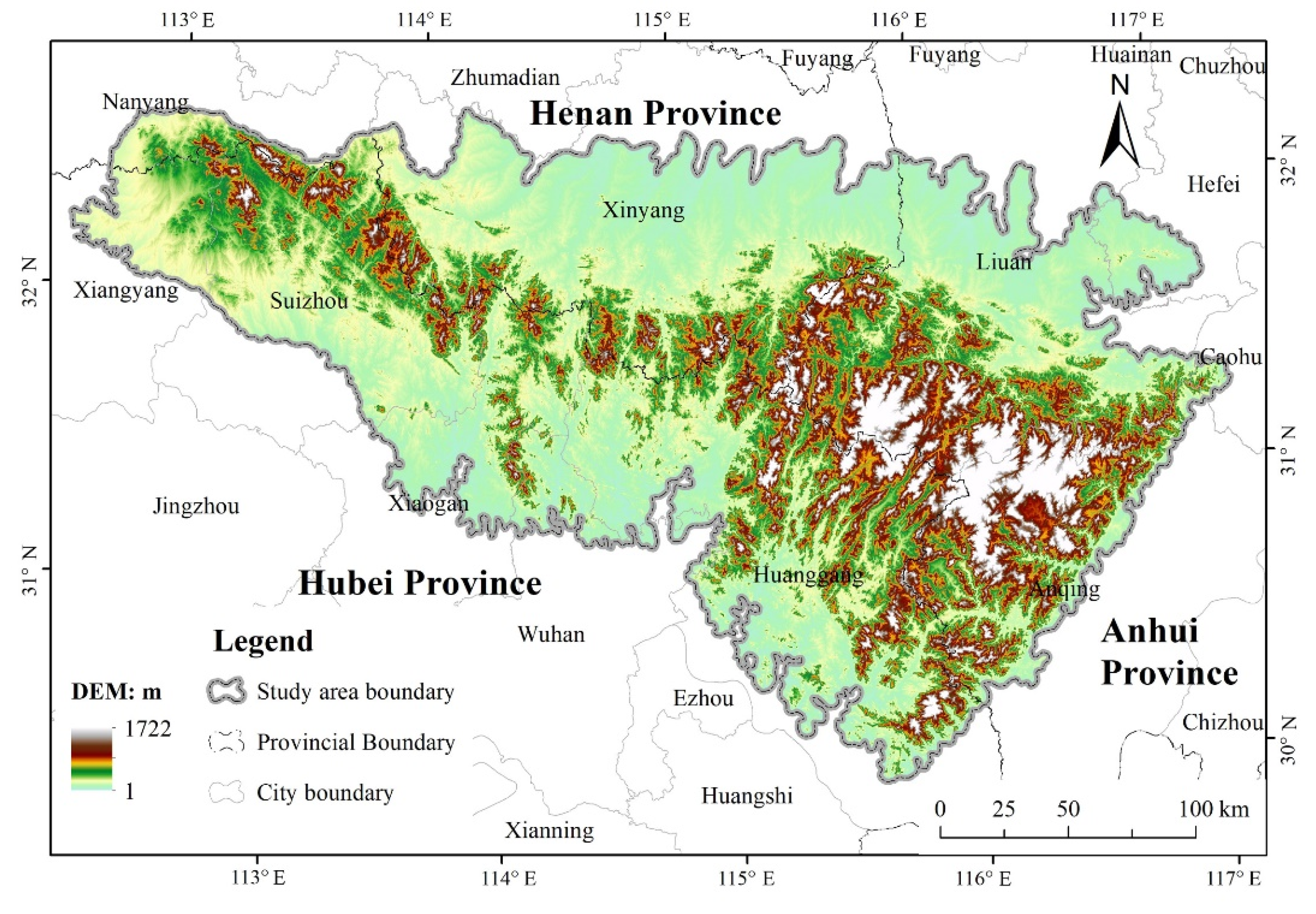
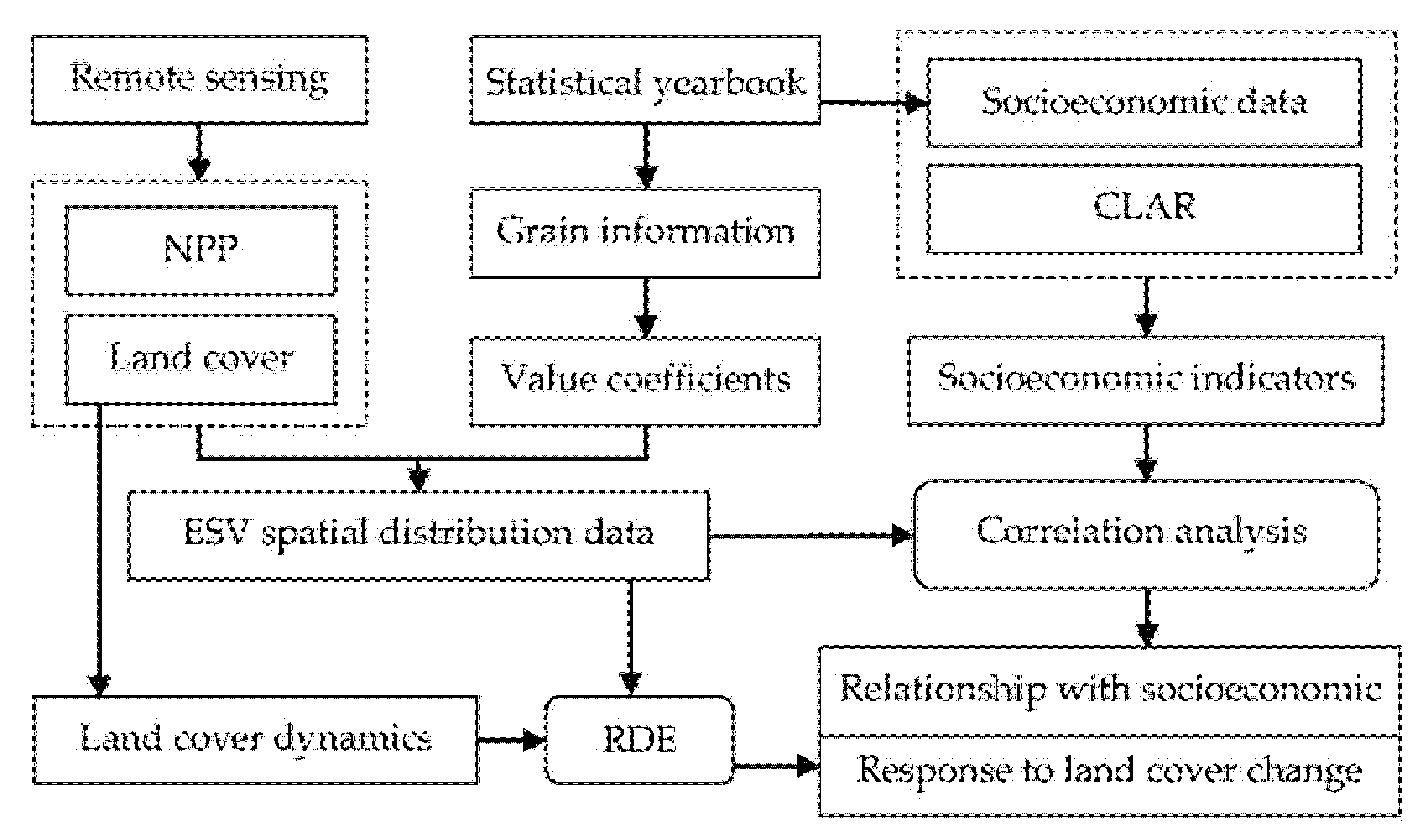
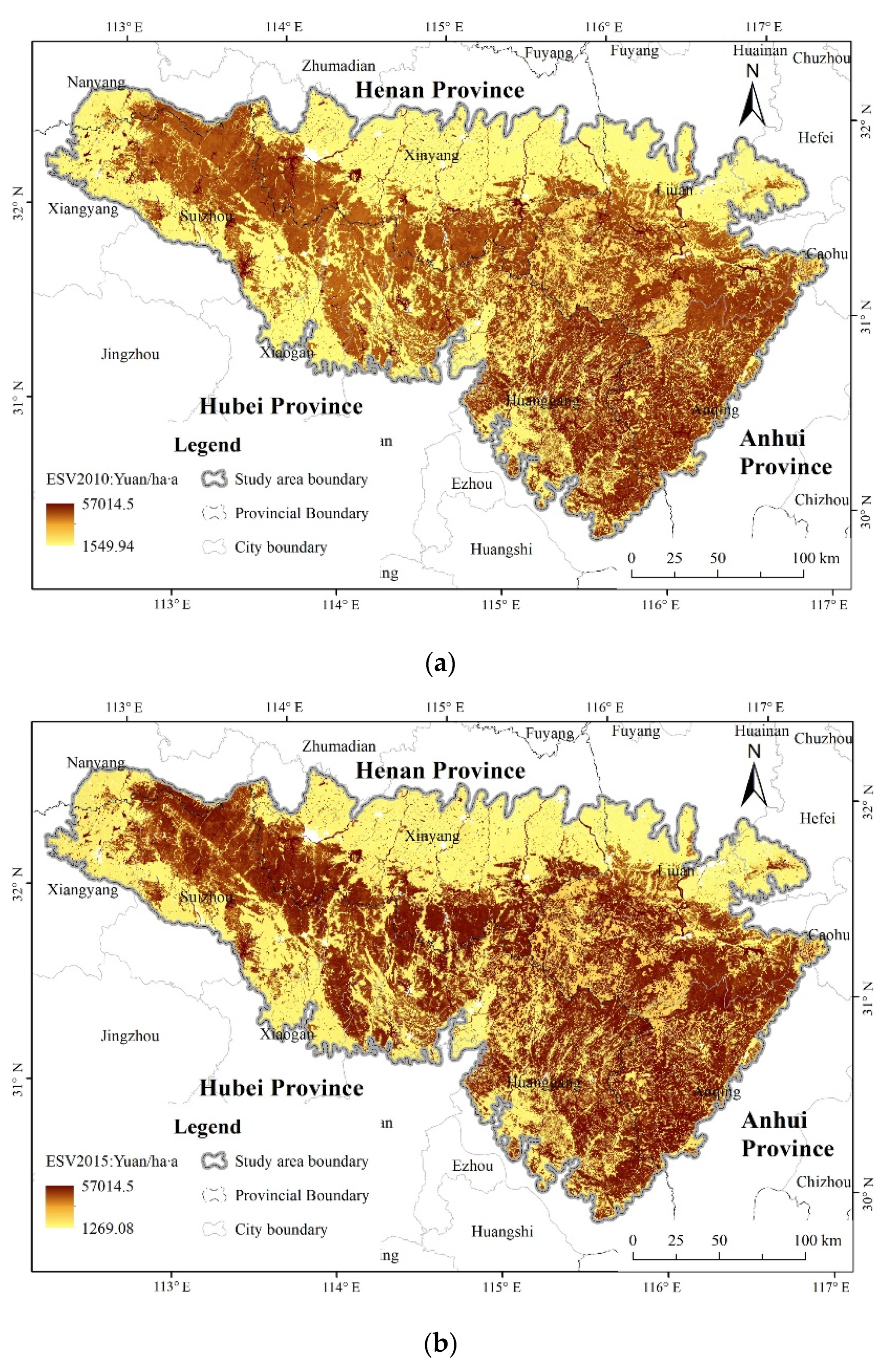
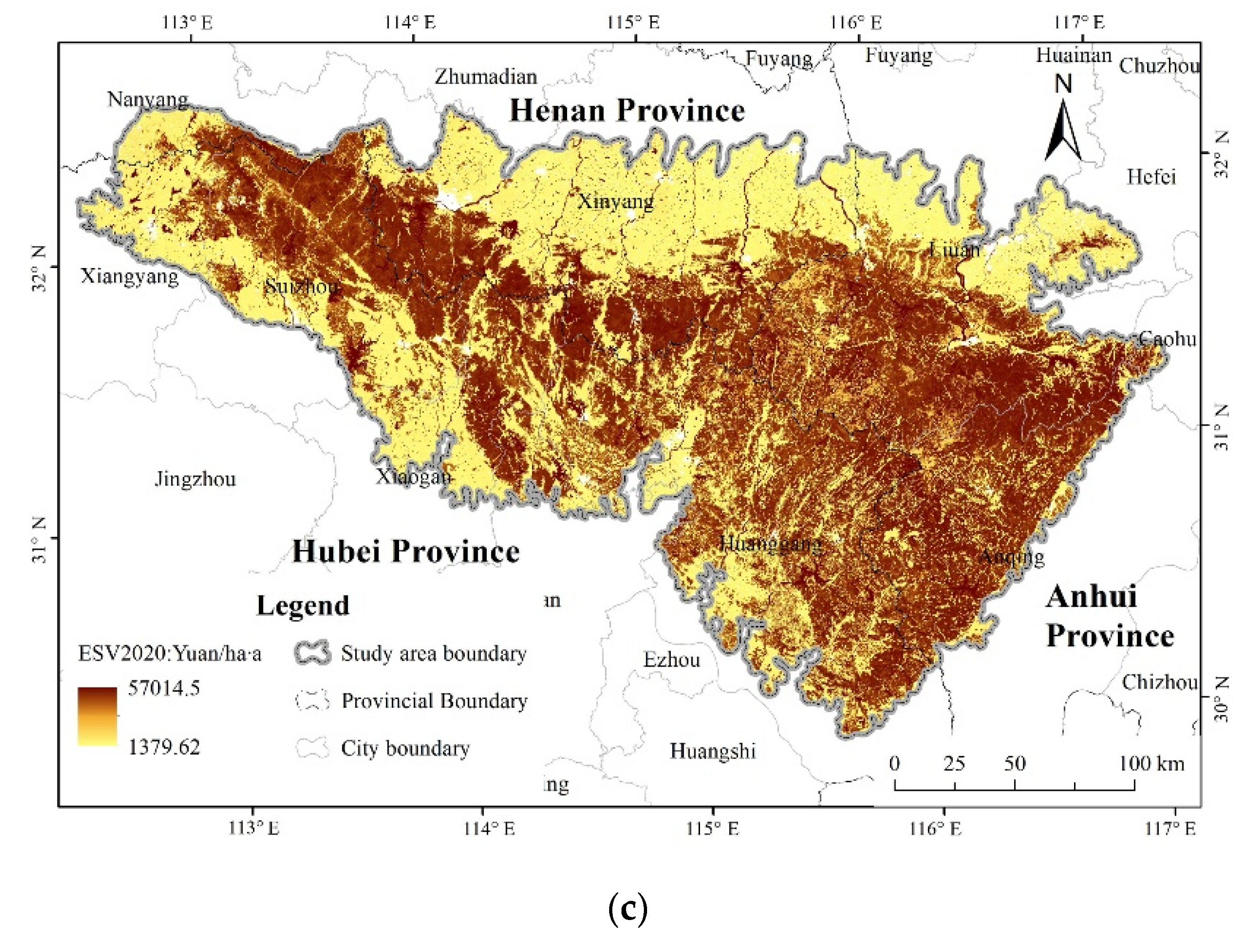
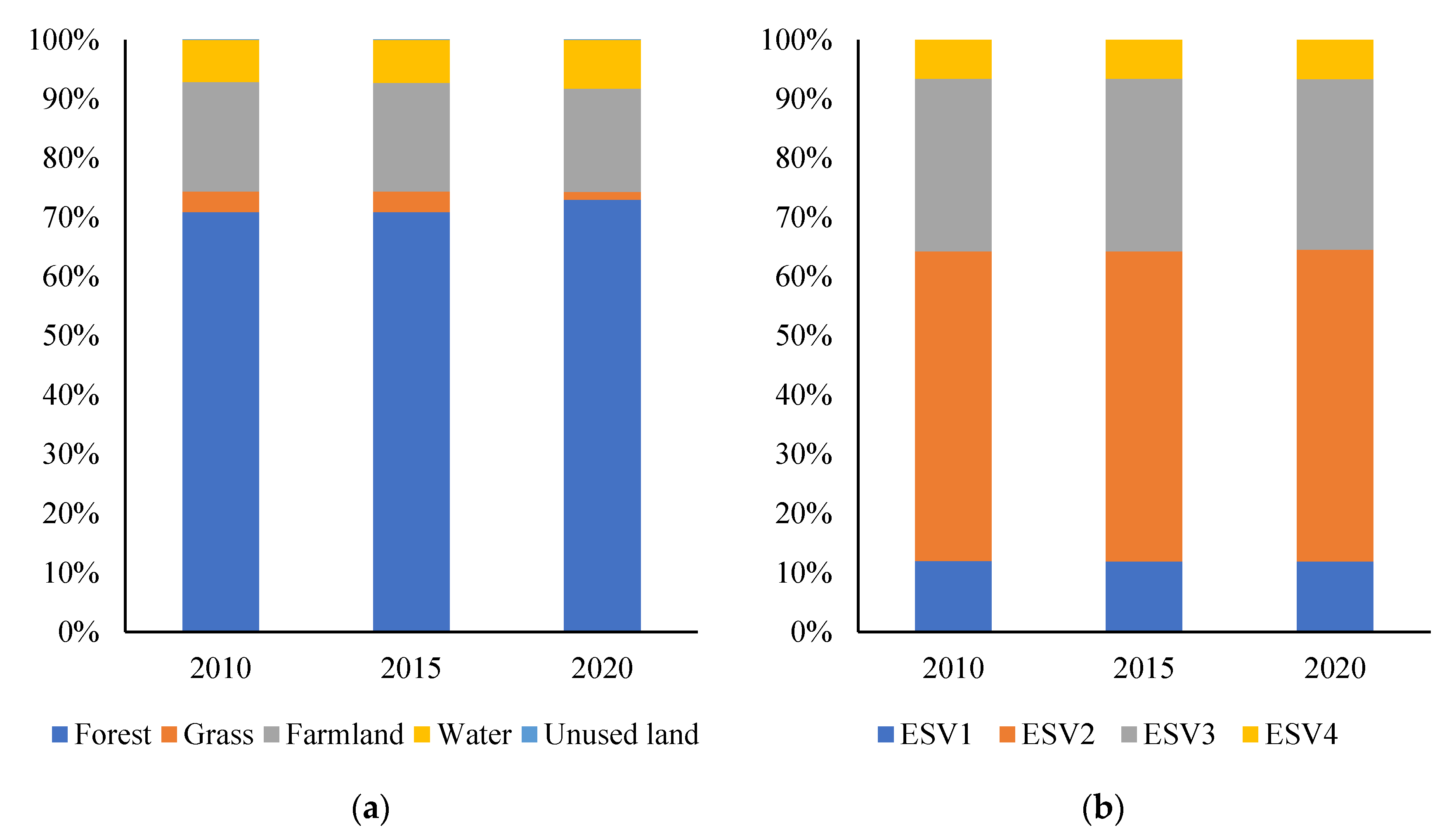
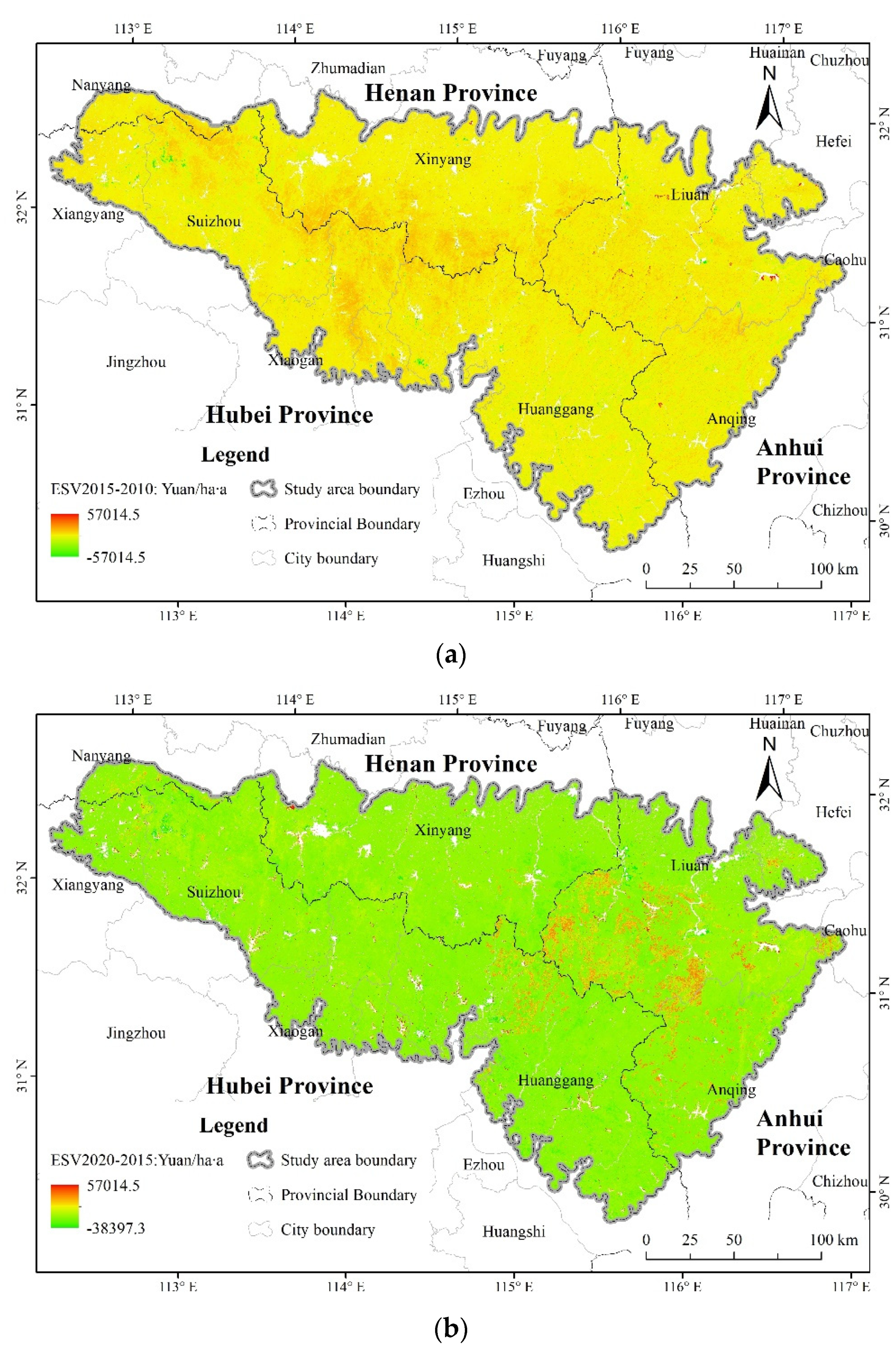
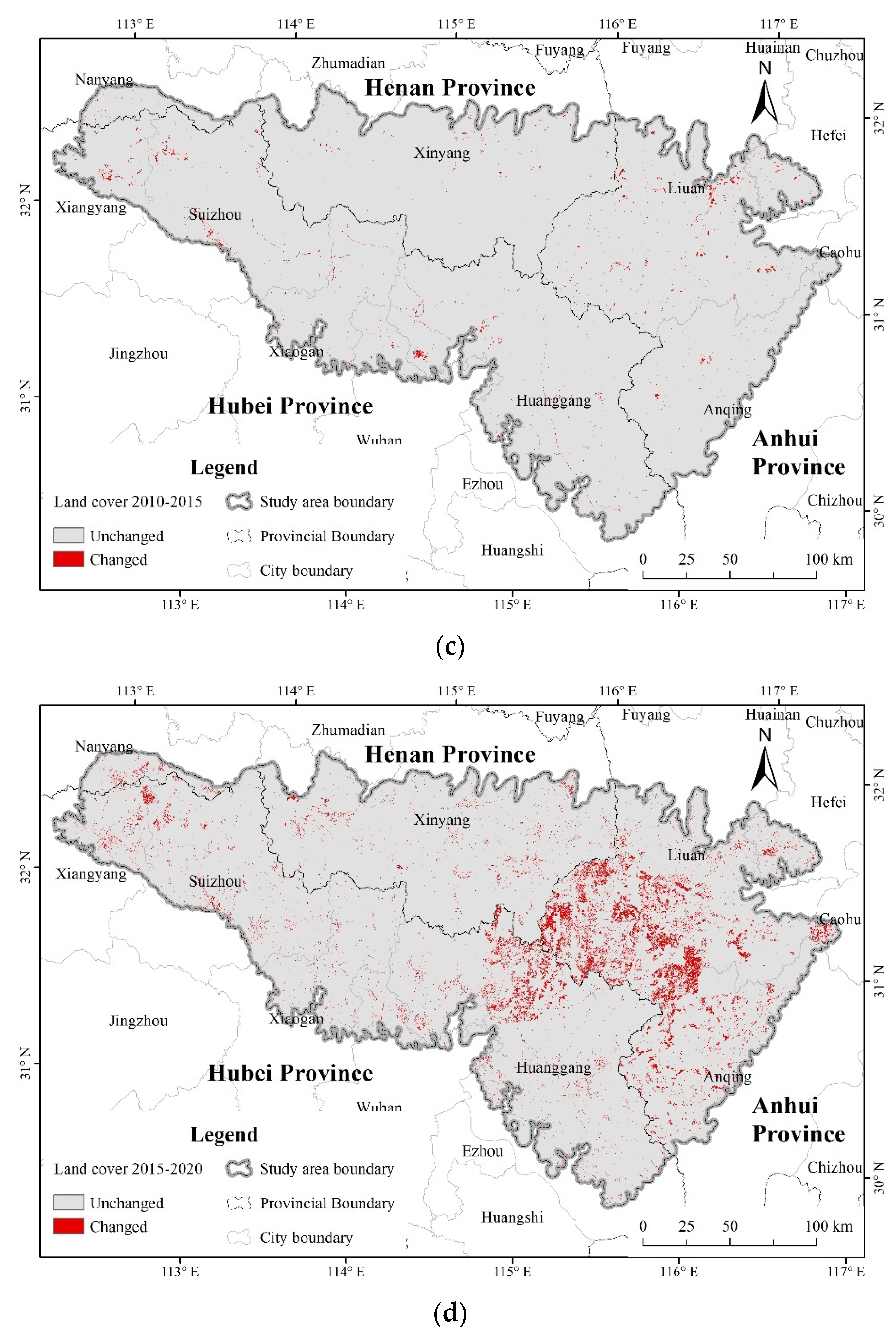
| Ecosystem Service Functions | Value Coefficients for Land Cover Types | |||||
|---|---|---|---|---|---|---|
| First-Level | Secondary-Level | Forest | Grass | Farmland | Water | Unused Land |
| Supply service (ESV1) | Grain production | 414.88 | 540.60 | 1257.21 | 666.32 | 25.14 |
| Raw material production | 3746.49 | 452.60 | 490.31 | 440.02 | 50.29 | |
| Regulation service (ESV2) | Gas regulation | 5431.15 | 1885.82 | 905.19 | 641.18 | 75.43 |
| Climate regulation | 5116.84 | 1961.25 | 1219.49 | 2589.85 | 163.44 | |
| Hydrological regulation | 5141.99 | 1910.96 | 968.05 | 23597.83 | 88.00 | |
| Waste disposal | 2162.40 | 1659.52 | 1747.52 | 18669.57 | 326.87 | |
| Support service (ESV3) | Soil conservation | 5053.98 | 2816.15 | 1848.10 | 515.46 | 213.73 |
| Biodiversity | 5670.02 | 2350.98 | 1282.35 | 4312.23 | 502.88 | |
| Cultural service (ESV4) | Aesthetic landscape | 2615.00 | 1093.77 | 213.73 | 5582.01 | 301.73 |
| Total | 35352.75 | 14671.64 | 9931.96 | 57014.47 | 1747.52 | |
| Categories | 2010 ESV | 2015 ESV | 2020 ESV | 2015–2010 | 2020–2015 | 2020–2010 | |||
|---|---|---|---|---|---|---|---|---|---|
| Forest | 988.61 | 70.92% | 985.75 | 70.89% | 1045.39 | 72.96% | −2.86 | 59.64 | 56.77 |
| Grass | 48.00 | 3.44% | 48.01 | 3.45% | 19.01 | 1.33% | 0.01 | −29.00 | −28.99 |
| Farmland | 257.94 | 18.50% | 255.66 | 18.39% | 249.65 | 17.42% | −2.28 | −6.01 | −8.29 |
| Water | 99.34 | 7.13% | 101.03 | 7.27% | 118.85 | 8.29% | 1.69 | 17.82 | 19.51 |
| Unused land | 0.06 | 0.00% | 0.06 | 0.00% | 0.01 | 0.00% | 0.00 | −0.05 | −0.05 |
| Total | 1393.96 | 100.00% | 1390.52 | 100.00% | 1432.91 | 100.00% | −3.44 | 42.39 | 38.95 |
| Categories | 2010 | 2015 | 2020 | 2015–2010 | 2020–2015 | 2020–2010 | |||
|---|---|---|---|---|---|---|---|---|---|
| Forest | 27,964.28 | 45.73% | 27,883.34 | 45.60% | 29,570.20 | 48.36% | −80.94 | 1686.86 | 1605.92 |
| Grass | 3271.94 | 5.35% | 3272.62 | 5.35% | 1295.93 | 2.12% | 0.68 | −1976.69 | −1976.02 |
| Farmland | 25,970.71 | 42.47% | 25,741.15 | 42.10% | 25,135.80 | 41.11% | −229.56 | −605.35 | −834.91 |
| Water | 1742.37 | 2.85% | 1772.01 | 2.90% | 2084.54 | 3.41% | 29.64 | 312.53 | 342.16 |
| Unused land | 36.80 | 0.06% | 36.63 | 0.06% | 6.75 | 0.01% | −0.17 | −29.88 | −30.05 |
| Built−up land | 2158.78 | 3.53% | 2439.14 | 3.99% | 3051.68 | 4.99% | 280.36 | 612.53 | 892.89 |
| Total | 61,144.89 | 100.00% | 61,144.89 | 100.00% | 61,144.89 | 100.00% | 0.00 | 0.00 | 0.00 |
| Functions | 2015–2010 CNY 108 | RDE 104 CNY/km2 | 2020–2015 CNY 108 | RDE 104 CNY/km2 | 2020–2010 CNY 108 | RDE 104 CNY/km2 |
|---|---|---|---|---|---|---|
| ∆ESV1 | −0.70 | 20.66 | 4.34 | 9.42 | 3.64 | 7.60 |
| ∆ESV2 | −1.20 | 35.27 | 26.72 | 57.95 | 25.52 | 53.29 |
| ∆ESV3 | −1.44 | 42.23 | 7.47 | 16.20 | 6.03 | 12.59 |
| ∆ESV4 | −0.09 | 2.77 | 3.86 | 8.36 | 3.76 | 7.85 |
| ∆ESV | −3.44 | 100.94 | 42.39 | 91.92 | 38.95 | 81.32 |
| Parameter Types | Relationships | 2010 | 2015 | 2020 |
|---|---|---|---|---|
| Socioeconomic parameters | ESV and PD | −0.3751 | −0.4533 | −0.4847 |
| ESV and GP | −0.6515 | −0.6423 | −0.5965 | |
| ESV and PI | −0.4150 | −0.3680 | −0.1978 | |
| ESV and PB | −0.8232 | −0.8524 | −0.8637 | |
| Land cover structure parameters | ESV and PF | 0.9788 | 0.9910 | 0.9936 |
| ESV and PG | 0.2820 | 0.2943 | 0.3871 | |
| ESV and PC | −0.9490 | −0.9618 | −0.9848 | |
| ESV and PW | −0.5883 | −0.5951 | −0.5833 | |
| ESV and PU | −0.2585 | −0.2704 | −0.2075 |
Publisher’s Note: MDPI stays neutral with regard to jurisdictional claims in published maps and institutional affiliations. |
© 2022 by the authors. Licensee MDPI, Basel, Switzerland. This article is an open access article distributed under the terms and conditions of the Creative Commons Attribution (CC BY) license (https://creativecommons.org/licenses/by/4.0/).
Share and Cite
Liu, J.; Chen, L.; Yang, Z.; Zhao, Y.; Zhang, X. Unraveling the Spatio-Temporal Relationship between Ecosystem Services and Socioeconomic Development in Dabie Mountain Area over the Last 10 years. Remote Sens. 2022, 14, 1059. https://doi.org/10.3390/rs14051059
Liu J, Chen L, Yang Z, Zhao Y, Zhang X. Unraveling the Spatio-Temporal Relationship between Ecosystem Services and Socioeconomic Development in Dabie Mountain Area over the Last 10 years. Remote Sensing. 2022; 14(5):1059. https://doi.org/10.3390/rs14051059
Chicago/Turabian StyleLiu, Jianfeng, Lin Chen, Zhonghua Yang, Yifan Zhao, and Xiwang Zhang. 2022. "Unraveling the Spatio-Temporal Relationship between Ecosystem Services and Socioeconomic Development in Dabie Mountain Area over the Last 10 years" Remote Sensing 14, no. 5: 1059. https://doi.org/10.3390/rs14051059
APA StyleLiu, J., Chen, L., Yang, Z., Zhao, Y., & Zhang, X. (2022). Unraveling the Spatio-Temporal Relationship between Ecosystem Services and Socioeconomic Development in Dabie Mountain Area over the Last 10 years. Remote Sensing, 14(5), 1059. https://doi.org/10.3390/rs14051059




